Law of Tort: An In-Depth Analysis of Key Legal Concepts and Principles
VerifiedAdded on 2020/06/04
|6
|2021
|89
Report
AI Summary
This report provides a comprehensive overview of the Law of Tort, delving into critical legal concepts and principles. It begins by defining the Law of Tort and its significance, then explores the interpretation of Res Ipsa Loquitur, the 'thing speaks for itself' doctrine, and its implications in establishing negligence. The report then analyzes the foreseeability test and causation, including factual and legal causation, with relevant case law examples. It further examines negligence, the duty of care, and the elements a plaintiff must prove. The report also discusses the legal defense of Volenti Non Fit Injuria, outlining its requirements and applications. Finally, it concludes by summarizing the key points and emphasizing the importance of understanding the Law of Tort for individuals and organizations, along with the concepts of vicarious and strict liability.
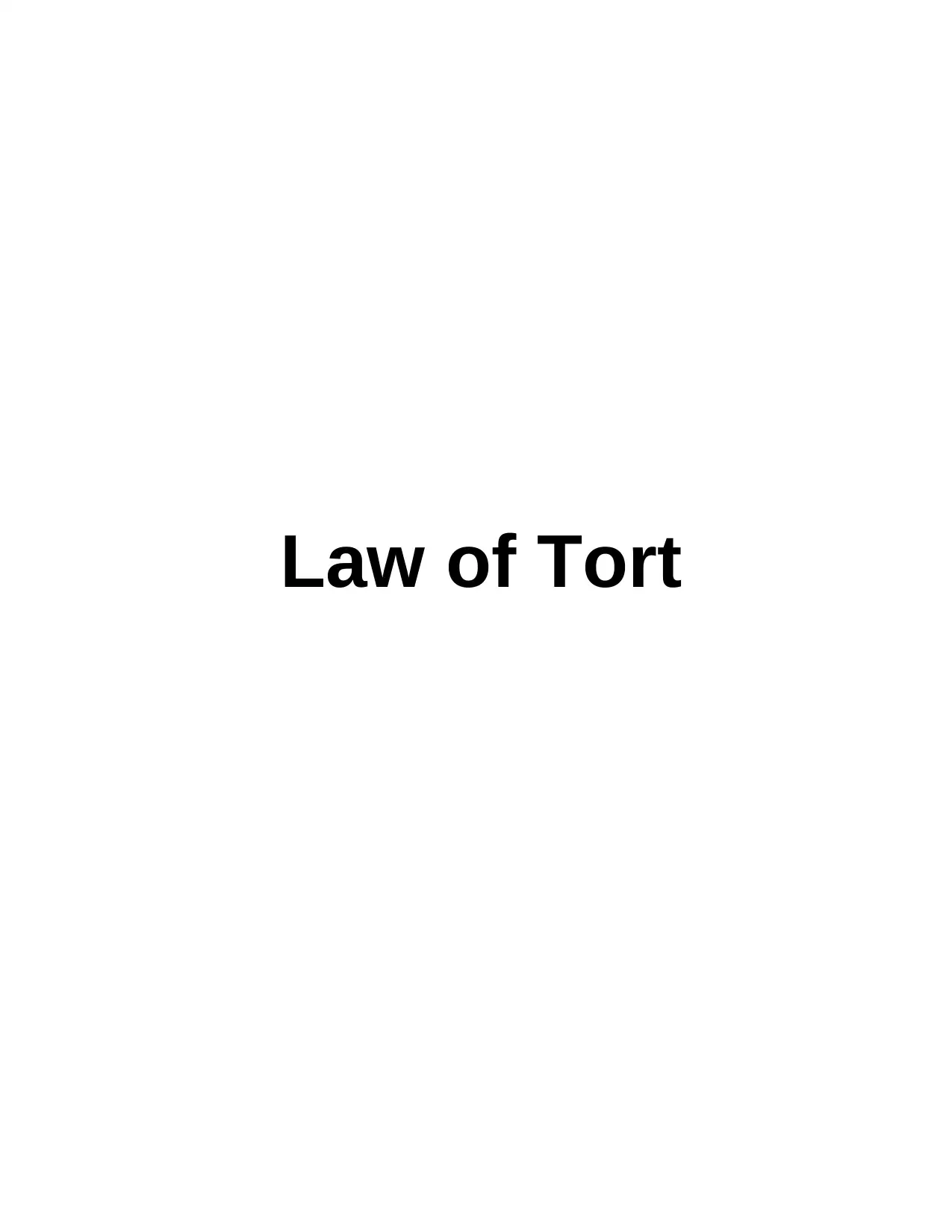
Law of Tort
Paraphrase This Document
Need a fresh take? Get an instant paraphrase of this document with our AI Paraphraser
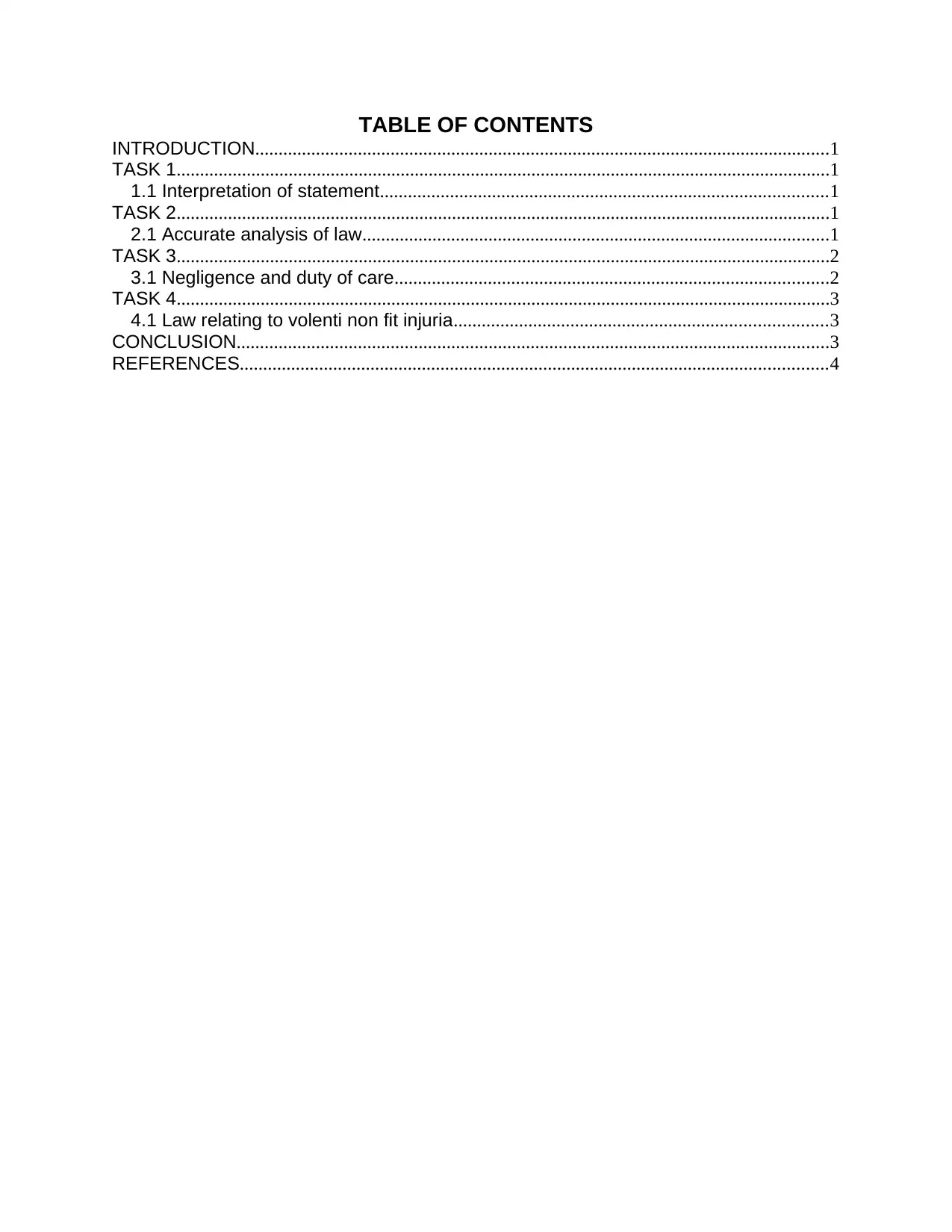
TABLE OF CONTENTS
INTRODUCTION...........................................................................................................................1
TASK 1............................................................................................................................................1
1.1 Interpretation of statement................................................................................................1
TASK 2............................................................................................................................................1
2.1 Accurate analysis of law....................................................................................................1
TASK 3............................................................................................................................................2
3.1 Negligence and duty of care.............................................................................................2
TASK 4............................................................................................................................................3
4.1 Law relating to volenti non fit injuria................................................................................3
CONCLUSION...............................................................................................................................3
REFERENCES..............................................................................................................................4
INTRODUCTION...........................................................................................................................1
TASK 1............................................................................................................................................1
1.1 Interpretation of statement................................................................................................1
TASK 2............................................................................................................................................1
2.1 Accurate analysis of law....................................................................................................1
TASK 3............................................................................................................................................2
3.1 Negligence and duty of care.............................................................................................2
TASK 4............................................................................................................................................3
4.1 Law relating to volenti non fit injuria................................................................................3
CONCLUSION...............................................................................................................................3
REFERENCES..............................................................................................................................4
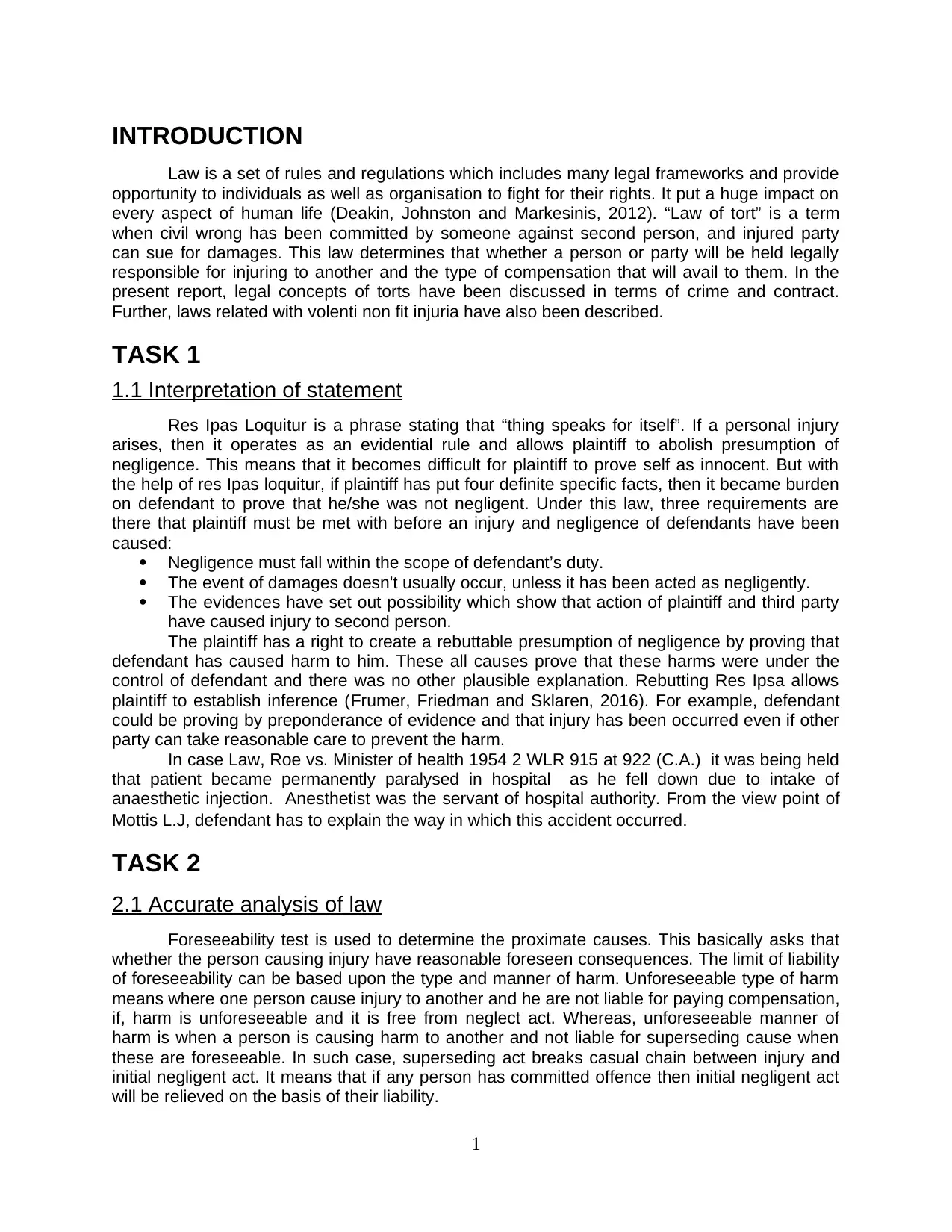
INTRODUCTION
Law is a set of rules and regulations which includes many legal frameworks and provide
opportunity to individuals as well as organisation to fight for their rights. It put a huge impact on
every aspect of human life (Deakin, Johnston and Markesinis, 2012). “Law of tort” is a term
when civil wrong has been committed by someone against second person, and injured party
can sue for damages. This law determines that whether a person or party will be held legally
responsible for injuring to another and the type of compensation that will avail to them. In the
present report, legal concepts of torts have been discussed in terms of crime and contract.
Further, laws related with volenti non fit injuria have also been described.
TASK 1
1.1 Interpretation of statement
Res Ipas Loquitur is a phrase stating that “thing speaks for itself”. If a personal injury
arises, then it operates as an evidential rule and allows plaintiff to abolish presumption of
negligence. This means that it becomes difficult for plaintiff to prove self as innocent. But with
the help of res Ipas loquitur, if plaintiff has put four definite specific facts, then it became burden
on defendant to prove that he/she was not negligent. Under this law, three requirements are
there that plaintiff must be met with before an injury and negligence of defendants have been
caused:
Negligence must fall within the scope of defendant’s duty.
The event of damages doesn't usually occur, unless it has been acted as negligently.
The evidences have set out possibility which show that action of plaintiff and third party
have caused injury to second person.
The plaintiff has a right to create a rebuttable presumption of negligence by proving that
defendant has caused harm to him. These all causes prove that these harms were under the
control of defendant and there was no other plausible explanation. Rebutting Res Ipsa allows
plaintiff to establish inference (Frumer, Friedman and Sklaren, 2016). For example, defendant
could be proving by preponderance of evidence and that injury has been occurred even if other
party can take reasonable care to prevent the harm.
In case Law, Roe vs. Minister of health 1954 2 WLR 915 at 922 (C.A.) it was being held
that patient became permanently paralysed in hospital as he fell down due to intake of
anaesthetic injection. Anesthetist was the servant of hospital authority. From the view point of
Mottis L.J, defendant has to explain the way in which this accident occurred.
TASK 2
2.1 Accurate analysis of law
Foreseeability test is used to determine the proximate causes. This basically asks that
whether the person causing injury have reasonable foreseen consequences. The limit of liability
of foreseeability can be based upon the type and manner of harm. Unforeseeable type of harm
means where one person cause injury to another and he are not liable for paying compensation,
if, harm is unforeseeable and it is free from neglect act. Whereas, unforeseeable manner of
harm is when a person is causing harm to another and not liable for superseding cause when
these are foreseeable. In such case, superseding act breaks casual chain between injury and
initial negligent act. It means that if any person has committed offence then initial negligent act
will be relieved on the basis of their liability.
1
Law is a set of rules and regulations which includes many legal frameworks and provide
opportunity to individuals as well as organisation to fight for their rights. It put a huge impact on
every aspect of human life (Deakin, Johnston and Markesinis, 2012). “Law of tort” is a term
when civil wrong has been committed by someone against second person, and injured party
can sue for damages. This law determines that whether a person or party will be held legally
responsible for injuring to another and the type of compensation that will avail to them. In the
present report, legal concepts of torts have been discussed in terms of crime and contract.
Further, laws related with volenti non fit injuria have also been described.
TASK 1
1.1 Interpretation of statement
Res Ipas Loquitur is a phrase stating that “thing speaks for itself”. If a personal injury
arises, then it operates as an evidential rule and allows plaintiff to abolish presumption of
negligence. This means that it becomes difficult for plaintiff to prove self as innocent. But with
the help of res Ipas loquitur, if plaintiff has put four definite specific facts, then it became burden
on defendant to prove that he/she was not negligent. Under this law, three requirements are
there that plaintiff must be met with before an injury and negligence of defendants have been
caused:
Negligence must fall within the scope of defendant’s duty.
The event of damages doesn't usually occur, unless it has been acted as negligently.
The evidences have set out possibility which show that action of plaintiff and third party
have caused injury to second person.
The plaintiff has a right to create a rebuttable presumption of negligence by proving that
defendant has caused harm to him. These all causes prove that these harms were under the
control of defendant and there was no other plausible explanation. Rebutting Res Ipsa allows
plaintiff to establish inference (Frumer, Friedman and Sklaren, 2016). For example, defendant
could be proving by preponderance of evidence and that injury has been occurred even if other
party can take reasonable care to prevent the harm.
In case Law, Roe vs. Minister of health 1954 2 WLR 915 at 922 (C.A.) it was being held
that patient became permanently paralysed in hospital as he fell down due to intake of
anaesthetic injection. Anesthetist was the servant of hospital authority. From the view point of
Mottis L.J, defendant has to explain the way in which this accident occurred.
TASK 2
2.1 Accurate analysis of law
Foreseeability test is used to determine the proximate causes. This basically asks that
whether the person causing injury have reasonable foreseen consequences. The limit of liability
of foreseeability can be based upon the type and manner of harm. Unforeseeable type of harm
means where one person cause injury to another and he are not liable for paying compensation,
if, harm is unforeseeable and it is free from neglect act. Whereas, unforeseeable manner of
harm is when a person is causing harm to another and not liable for superseding cause when
these are foreseeable. In such case, superseding act breaks casual chain between injury and
initial negligent act. It means that if any person has committed offence then initial negligent act
will be relieved on the basis of their liability.
1
You're viewing a preview
Unlock full access by subscribing today!
Enjoy unlimited downloads | Full document access |
Advanced AI study tools
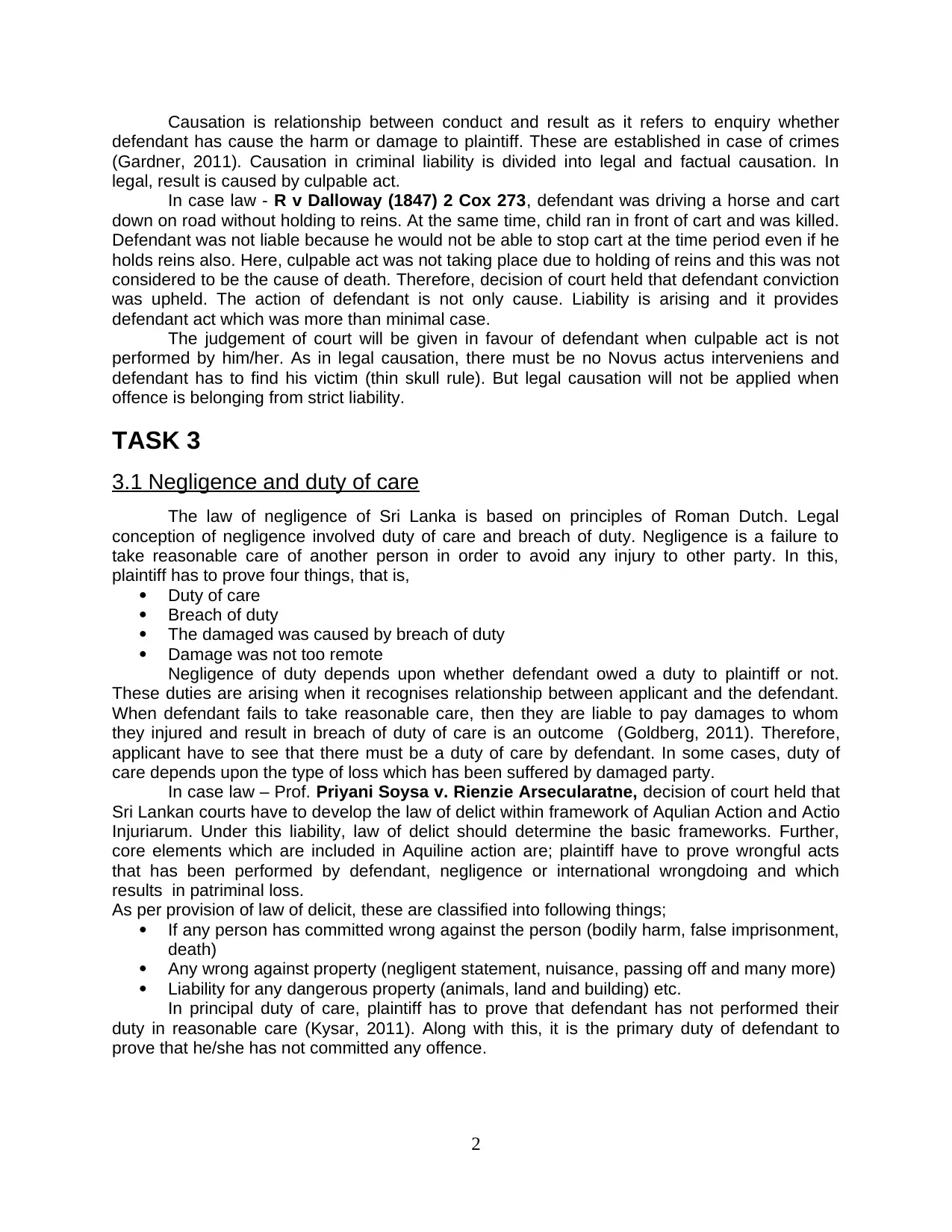
Causation is relationship between conduct and result as it refers to enquiry whether
defendant has cause the harm or damage to plaintiff. These are established in case of crimes
(Gardner, 2011). Causation in criminal liability is divided into legal and factual causation. In
legal, result is caused by culpable act.
In case law - R v Dalloway (1847) 2 Cox 273, defendant was driving a horse and cart
down on road without holding to reins. At the same time, child ran in front of cart and was killed.
Defendant was not liable because he would not be able to stop cart at the time period even if he
holds reins also. Here, culpable act was not taking place due to holding of reins and this was not
considered to be the cause of death. Therefore, decision of court held that defendant conviction
was upheld. The action of defendant is not only cause. Liability is arising and it provides
defendant act which was more than minimal case.
The judgement of court will be given in favour of defendant when culpable act is not
performed by him/her. As in legal causation, there must be no Novus actus interveniens and
defendant has to find his victim (thin skull rule). But legal causation will not be applied when
offence is belonging from strict liability.
TASK 3
3.1 Negligence and duty of care
The law of negligence of Sri Lanka is based on principles of Roman Dutch. Legal
conception of negligence involved duty of care and breach of duty. Negligence is a failure to
take reasonable care of another person in order to avoid any injury to other party. In this,
plaintiff has to prove four things, that is,
Duty of care
Breach of duty
The damaged was caused by breach of duty
Damage was not too remote
Negligence of duty depends upon whether defendant owed a duty to plaintiff or not.
These duties are arising when it recognises relationship between applicant and the defendant.
When defendant fails to take reasonable care, then they are liable to pay damages to whom
they injured and result in breach of duty of care is an outcome (Goldberg, 2011). Therefore,
applicant have to see that there must be a duty of care by defendant. In some cases, duty of
care depends upon the type of loss which has been suffered by damaged party.
In case law – Prof. Priyani Soysa v. Rienzie Arsecularatne, decision of court held that
Sri Lankan courts have to develop the law of delict within framework of Aqulian Action and Actio
Injuriarum. Under this liability, law of delict should determine the basic frameworks. Further,
core elements which are included in Aquiline action are; plaintiff have to prove wrongful acts
that has been performed by defendant, negligence or international wrongdoing and which
results in patriminal loss.
As per provision of law of delicit, these are classified into following things;
If any person has committed wrong against the person (bodily harm, false imprisonment,
death)
Any wrong against property (negligent statement, nuisance, passing off and many more)
Liability for any dangerous property (animals, land and building) etc.
In principal duty of care, plaintiff has to prove that defendant has not performed their
duty in reasonable care (Kysar, 2011). Along with this, it is the primary duty of defendant to
prove that he/she has not committed any offence.
2
defendant has cause the harm or damage to plaintiff. These are established in case of crimes
(Gardner, 2011). Causation in criminal liability is divided into legal and factual causation. In
legal, result is caused by culpable act.
In case law - R v Dalloway (1847) 2 Cox 273, defendant was driving a horse and cart
down on road without holding to reins. At the same time, child ran in front of cart and was killed.
Defendant was not liable because he would not be able to stop cart at the time period even if he
holds reins also. Here, culpable act was not taking place due to holding of reins and this was not
considered to be the cause of death. Therefore, decision of court held that defendant conviction
was upheld. The action of defendant is not only cause. Liability is arising and it provides
defendant act which was more than minimal case.
The judgement of court will be given in favour of defendant when culpable act is not
performed by him/her. As in legal causation, there must be no Novus actus interveniens and
defendant has to find his victim (thin skull rule). But legal causation will not be applied when
offence is belonging from strict liability.
TASK 3
3.1 Negligence and duty of care
The law of negligence of Sri Lanka is based on principles of Roman Dutch. Legal
conception of negligence involved duty of care and breach of duty. Negligence is a failure to
take reasonable care of another person in order to avoid any injury to other party. In this,
plaintiff has to prove four things, that is,
Duty of care
Breach of duty
The damaged was caused by breach of duty
Damage was not too remote
Negligence of duty depends upon whether defendant owed a duty to plaintiff or not.
These duties are arising when it recognises relationship between applicant and the defendant.
When defendant fails to take reasonable care, then they are liable to pay damages to whom
they injured and result in breach of duty of care is an outcome (Goldberg, 2011). Therefore,
applicant have to see that there must be a duty of care by defendant. In some cases, duty of
care depends upon the type of loss which has been suffered by damaged party.
In case law – Prof. Priyani Soysa v. Rienzie Arsecularatne, decision of court held that
Sri Lankan courts have to develop the law of delict within framework of Aqulian Action and Actio
Injuriarum. Under this liability, law of delict should determine the basic frameworks. Further,
core elements which are included in Aquiline action are; plaintiff have to prove wrongful acts
that has been performed by defendant, negligence or international wrongdoing and which
results in patriminal loss.
As per provision of law of delicit, these are classified into following things;
If any person has committed wrong against the person (bodily harm, false imprisonment,
death)
Any wrong against property (negligent statement, nuisance, passing off and many more)
Liability for any dangerous property (animals, land and building) etc.
In principal duty of care, plaintiff has to prove that defendant has not performed their
duty in reasonable care (Kysar, 2011). Along with this, it is the primary duty of defendant to
prove that he/she has not committed any offence.
2
Paraphrase This Document
Need a fresh take? Get an instant paraphrase of this document with our AI Paraphraser
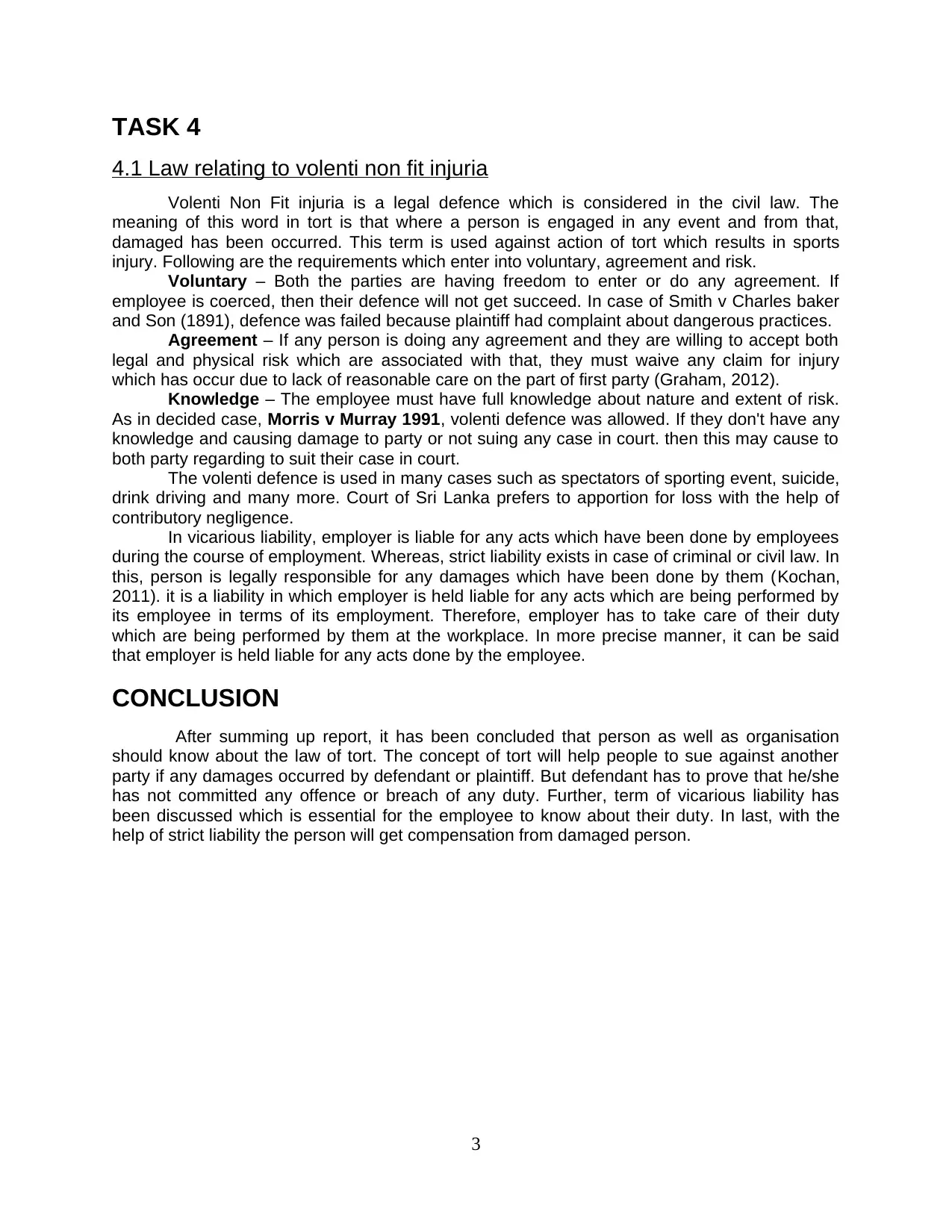
TASK 4
4.1 Law relating to volenti non fit injuria
Volenti Non Fit injuria is a legal defence which is considered in the civil law. The
meaning of this word in tort is that where a person is engaged in any event and from that,
damaged has been occurred. This term is used against action of tort which results in sports
injury. Following are the requirements which enter into voluntary, agreement and risk.
Voluntary – Both the parties are having freedom to enter or do any agreement. If
employee is coerced, then their defence will not get succeed. In case of Smith v Charles baker
and Son (1891), defence was failed because plaintiff had complaint about dangerous practices.
Agreement – If any person is doing any agreement and they are willing to accept both
legal and physical risk which are associated with that, they must waive any claim for injury
which has occur due to lack of reasonable care on the part of first party (Graham, 2012).
Knowledge – The employee must have full knowledge about nature and extent of risk.
As in decided case, Morris v Murray 1991, volenti defence was allowed. If they don't have any
knowledge and causing damage to party or not suing any case in court. then this may cause to
both party regarding to suit their case in court.
The volenti defence is used in many cases such as spectators of sporting event, suicide,
drink driving and many more. Court of Sri Lanka prefers to apportion for loss with the help of
contributory negligence.
In vicarious liability, employer is liable for any acts which have been done by employees
during the course of employment. Whereas, strict liability exists in case of criminal or civil law. In
this, person is legally responsible for any damages which have been done by them (Kochan,
2011). it is a liability in which employer is held liable for any acts which are being performed by
its employee in terms of its employment. Therefore, employer has to take care of their duty
which are being performed by them at the workplace. In more precise manner, it can be said
that employer is held liable for any acts done by the employee.
CONCLUSION
After summing up report, it has been concluded that person as well as organisation
should know about the law of tort. The concept of tort will help people to sue against another
party if any damages occurred by defendant or plaintiff. But defendant has to prove that he/she
has not committed any offence or breach of any duty. Further, term of vicarious liability has
been discussed which is essential for the employee to know about their duty. In last, with the
help of strict liability the person will get compensation from damaged person.
3
4.1 Law relating to volenti non fit injuria
Volenti Non Fit injuria is a legal defence which is considered in the civil law. The
meaning of this word in tort is that where a person is engaged in any event and from that,
damaged has been occurred. This term is used against action of tort which results in sports
injury. Following are the requirements which enter into voluntary, agreement and risk.
Voluntary – Both the parties are having freedom to enter or do any agreement. If
employee is coerced, then their defence will not get succeed. In case of Smith v Charles baker
and Son (1891), defence was failed because plaintiff had complaint about dangerous practices.
Agreement – If any person is doing any agreement and they are willing to accept both
legal and physical risk which are associated with that, they must waive any claim for injury
which has occur due to lack of reasonable care on the part of first party (Graham, 2012).
Knowledge – The employee must have full knowledge about nature and extent of risk.
As in decided case, Morris v Murray 1991, volenti defence was allowed. If they don't have any
knowledge and causing damage to party or not suing any case in court. then this may cause to
both party regarding to suit their case in court.
The volenti defence is used in many cases such as spectators of sporting event, suicide,
drink driving and many more. Court of Sri Lanka prefers to apportion for loss with the help of
contributory negligence.
In vicarious liability, employer is liable for any acts which have been done by employees
during the course of employment. Whereas, strict liability exists in case of criminal or civil law. In
this, person is legally responsible for any damages which have been done by them (Kochan,
2011). it is a liability in which employer is held liable for any acts which are being performed by
its employee in terms of its employment. Therefore, employer has to take care of their duty
which are being performed by them at the workplace. In more precise manner, it can be said
that employer is held liable for any acts done by the employee.
CONCLUSION
After summing up report, it has been concluded that person as well as organisation
should know about the law of tort. The concept of tort will help people to sue against another
party if any damages occurred by defendant or plaintiff. But defendant has to prove that he/she
has not committed any offence or breach of any duty. Further, term of vicarious liability has
been discussed which is essential for the employee to know about their duty. In last, with the
help of strict liability the person will get compensation from damaged person.
3
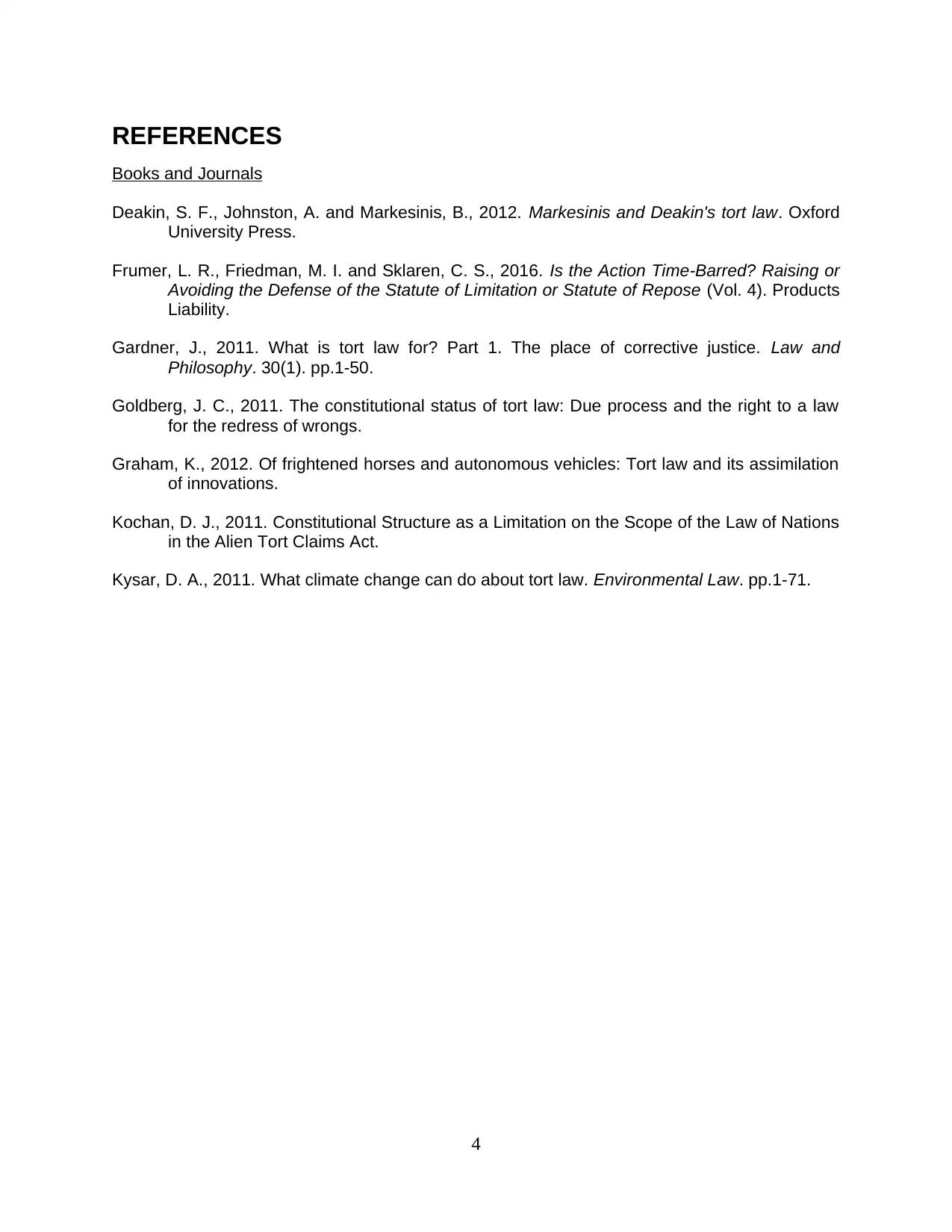
REFERENCES
Books and Journals
Deakin, S. F., Johnston, A. and Markesinis, B., 2012. Markesinis and Deakin's tort law. Oxford
University Press.
Frumer, L. R., Friedman, M. I. and Sklaren, C. S., 2016. Is the Action Time-Barred? Raising or
Avoiding the Defense of the Statute of Limitation or Statute of Repose (Vol. 4). Products
Liability.
Gardner, J., 2011. What is tort law for? Part 1. The place of corrective justice. Law and
Philosophy. 30(1). pp.1-50.
Goldberg, J. C., 2011. The constitutional status of tort law: Due process and the right to a law
for the redress of wrongs.
Graham, K., 2012. Of frightened horses and autonomous vehicles: Tort law and its assimilation
of innovations.
Kochan, D. J., 2011. Constitutional Structure as a Limitation on the Scope of the Law of Nations
in the Alien Tort Claims Act.
Kysar, D. A., 2011. What climate change can do about tort law. Environmental Law. pp.1-71.
4
Books and Journals
Deakin, S. F., Johnston, A. and Markesinis, B., 2012. Markesinis and Deakin's tort law. Oxford
University Press.
Frumer, L. R., Friedman, M. I. and Sklaren, C. S., 2016. Is the Action Time-Barred? Raising or
Avoiding the Defense of the Statute of Limitation or Statute of Repose (Vol. 4). Products
Liability.
Gardner, J., 2011. What is tort law for? Part 1. The place of corrective justice. Law and
Philosophy. 30(1). pp.1-50.
Goldberg, J. C., 2011. The constitutional status of tort law: Due process and the right to a law
for the redress of wrongs.
Graham, K., 2012. Of frightened horses and autonomous vehicles: Tort law and its assimilation
of innovations.
Kochan, D. J., 2011. Constitutional Structure as a Limitation on the Scope of the Law of Nations
in the Alien Tort Claims Act.
Kysar, D. A., 2011. What climate change can do about tort law. Environmental Law. pp.1-71.
4
You're viewing a preview
Unlock full access by subscribing today!
Enjoy unlimited downloads | Full document access |
Advanced AI study tools
1 out of 6
Related Documents
Your All-in-One AI-Powered Toolkit for Academic Success.
+13062052269
info@desklib.com
Available 24*7 on WhatsApp / Email
![[object Object]](/_next/static/media/star-bottom.7253800d.svg)
Unlock your academic potential
© 2024 | Zucol Services PVT LTD | All rights reserved.



